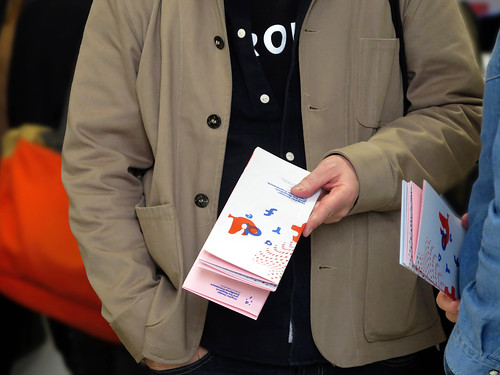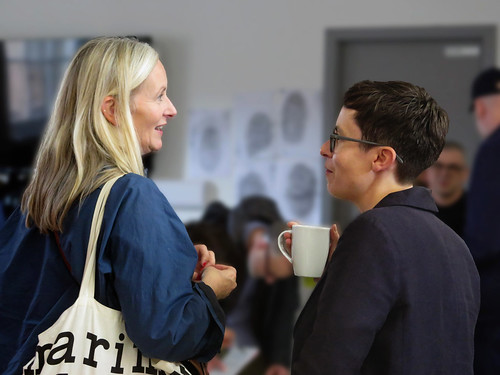Friday, 10:00am
9 November 2018
If you know where to look …
Graphic Design and the Research Excellence Framework
Co-hosted by GDEN, CHEAD, ADRC, and SIA, 17 October 2018<br> Sheffield Institute of Arts, Sheffield Hallam University<br>Graphic design academics assemble in Sheffield to prepare for the next REF, the Research Excellence Framework. Report by Steve Rigley

The Research Excellence Framework (REF), which takes place every seven years, is the means by which UK funding councils assess the quality and impact of academic research in higher education, writes Steve Rigley.
While the suitability of the REF mechanism continues to divide opinion, the incentives to institutions are clear, with prestige and a slice of the £2b annual funding going to those with high-scoring outcomes. Last month, a sold-out, one-day symposium in Sheffield attempted to address the challenges facing university graphic design departments who would like a larger slice of the research funding cake.
The REF is strategically important, since Art and Design departments are rarely able to draw from the various, often substantial, funding sources for STEM subjects [science, technology, engineering and mathematics].
Following the 2014 exercise, a statement from CHEAD, the Council for Higher Education in Art and Design noted that ‘Art and Design is competitive in the premier league of research excellence … has produced a strong performance across all elements of the REF.’ 1 Yet sadly, this had not been consistent across the disciplines. The Panel Report for UOA 34 [the Unit Of Assessment for Art and Design: History, Practice and Theory] concluded that ‘the intellectual and theoretical underpinning’ of graphic design submissions was ‘generically weak’ and showed little sign of improvement since the 2008 audit. 2
Sue Walker, a member of the panel, later tried to soften the blow by claiming that graphic design research is actually thriving, ‘if you know where to look’, and offered a range of examples of archival, historical and practice-based research, many from Reading, her own University. 3

Aside from sharing field notes on other thriving locations, delegates – mainly graphic design academics – gathered for this special symposium to consider two questions from the perspective of the REF. First: ‘How do we foster graphic design research and make it visible within established academic contexts?’ Second: ‘What can the disciplinary knowledge practices of graphic design research offer established academic contexts?’
The afternoon kicked off with a lively keynote address from Professor Anne Boddington, Pro Vice-Chancellor for Research, Business and Innovation at Kingston University, and chair of the panel for Art and Design for the next REF in 2021. Pulling few punches, she implored delegates to think in broader, more societal terms, to consider and articulate ‘impact’ as ‘the difference we make and the evidence for the difference we make’. Research, she suggested, was a pedagogic challenge, since currently ‘we teach projects, not research’. Laying down a challenge for the presentations to follow, she concluded by asking designers and educators to consider how they might articulate more clearly the contribution of graphic design to society.
Following on, James Corazzo (Sheffield Hallam University), Robert Harland (Loughborough University) and I presented findings from a two-year GDEN/CHEAD-sponsored project to map graphic design outputs from REF2014. Of the 6321 submissions to UOA 34, only 190 could be classified as graphic design: a mere three per cent for arguably one of the largest and most popular disciplines. Five institutions accounted for nearly half of this figure. Digging deeper into the output narratives, the team found a dearth of clear research questions, general confusion over nomenclature, and a worrying lack of confidence asserting and articulating their contributions to collaborative projects.
The gathering gloom soon lifted with three shorter presentations showcasing research projects. Rebecca Ross (Central St Martins) offered a pacey account of the challenges disseminating a successful, highly experimental practice-based research project through the conventional channel of peer-reviewed journals. While Ross admitted that her work for ‘London is Changing’ would not satisfy fully the REF demand for ‘originality, significance and rigour’, 4 she was confident that the outcome offered new insights into facilitating a dynamic and inclusive city-wide discourse.
Paul Bailey (London College of Communication) presented a range of projects generated from within the MA Graphic Media Design course. The explorations into sound, language and interaction demonstrated how a community of educators and students might collaborate from within a programme to expand the frontiers of their practice.
Finally, Alison Barnes, (also London College of Communication) gave an honest and insightful description of her research journey in social geography, admitting how early forays into research felt like ‘looking for the door to Narnia’.
After a brief plenary, many delegates reconvened in the Sheffield train station bar; the common observation was of a door opening, ever so slightly.

ENDNOTES
1. https://chead.ac.uk/wp-content/uploads/2014/12/REF-results-CHEAD-statement.pdf
2. REF. (2014) Panel overview reports UoA 34: Art and Design: History, Practice and Theory p.85
3. Walker, S. (2017) Research in graphic design. The Design Journal, 20 (5). pp. 549-559.
4. https://www.ref.ac.uk/2014/panels/assessmentcriteriaandleveldefinitions/
Steve Rigley, designer, lecturer, writer, Glasgow School of Art
Eye is the world’s most beautiful and collectable graphic design journal, published quarterly for professional designers, students and anyone interested in critical, informed writing about graphic design and visual culture. It is available from all good design bookshops and online at the Eye shop, where you can buy subscriptions, back issues and single copies of the latest issue.
